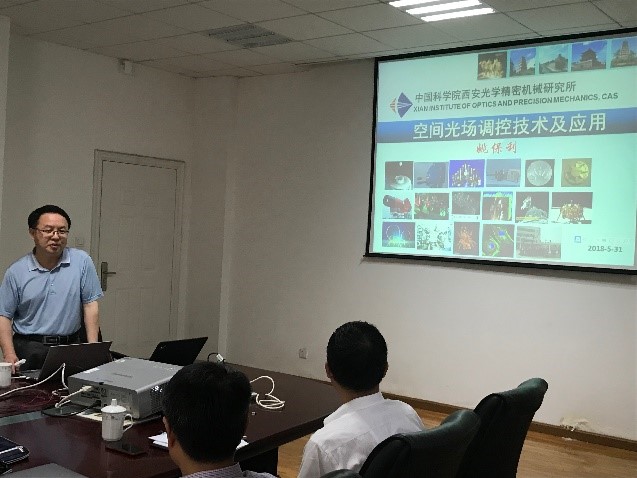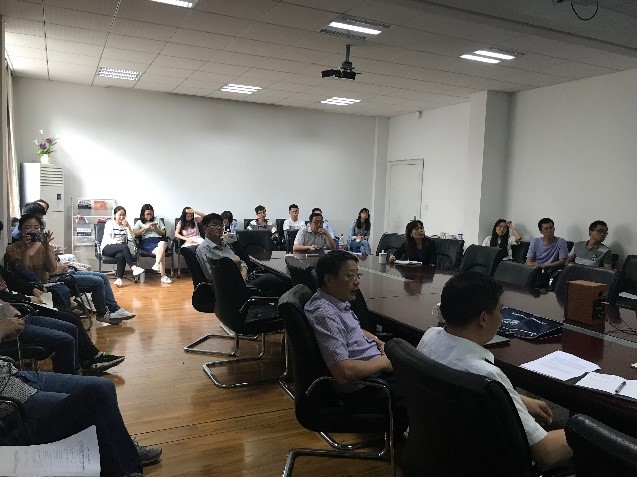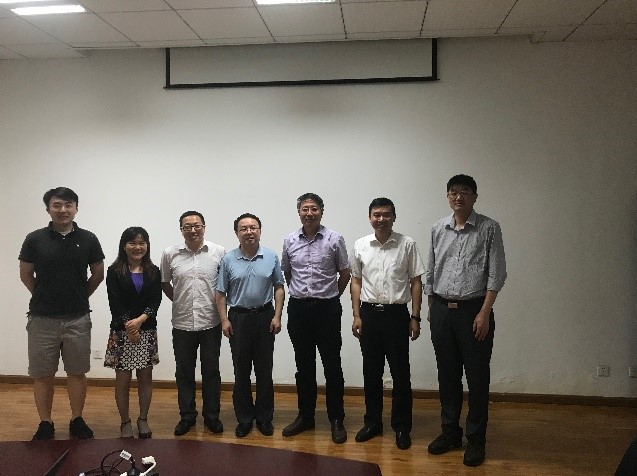On May 31, 2018, the lecture of optical field manipulation, hosted by Advanced Photonics Center (APC) at Southeast University, was successfully held in the conference room of Jinling building. Prof. Bing Gu chaired this forum, which consists of two speakers: Prof. Baoli Yao from Xi’an Institute of Optical and Precision Machinery, Chinese Academy of Sciences (CAS), and Prof. Jianping Ding from Nanjing University, some teachers and graduate students from APC and other universities attended the lectures.
Two lectures addressing different application of light manipulation technique are given by the speakers, which are “Spatial light manipulation technology and its application” and “Construction of optical vector beams in three dimensions”.




Prof. Baoli Yao introduced the technology of spatial light field manipulation, optical micromanipulation technique and its applications, holographic optical tweezers, vector/vortex optical field micromanipulation theory and super-resolution imaging based on spatial optical field modulation. Among them, optical micromanipulation technique has the “optical tweezers” depending on the momentum of light, the “light knife” depending on the energy of light, and the “light wrench” based on the angular momentum of light, which can be used to trap, pull, move, rotate, transport and separate particles. Prof. Yao focuses on the application of optical tweezers in the field of biological cell imaging, which can be used to flexibly realize the three-dimensional (3D) movement of different trajectories of cells, the screening and fusion of cells. These are impressive in the microcosmic manipulation of particles.
Prof. Jianping Ding’s report introduces the research background of light field manipulation in three dimensions, the construction and generation of focal field in 3D space, studied the scalar manipulation and vector manipulation of the 3D focal field. The light field manipulation in three dimensions can control the spatial structure of the light field and realize the tailoring of the photon as an information carrier. Meanwhile, it can produce new degrees of freedom, new effects and new applications. Based on Fourier transform theory and phase shift principle, 3D focal field can be generated through a series of iterative or non-iterative algorithms. As the same time, the prospect of shaping of optical beams in 3D and further application in optical tweezers system are also put forward.
After the reports, we had a discussion and exchange in view of the development trend and problems in the field of light manipulation. This forum strengthened academic exchanges between teachers and students, deepen our understanding in the spatial light field manipulation technology and application and construction of optical vector beams in three dimensions, and provided a good opportunity to boost the scientific research level and expanded the research area in APC. In particular, the application of light field manipulation technique in the field of biological imaging provides a good opportunity for the scientific research of APC to be cross integration of scientific research, improving the level of scientific research and development of the research content.
A brief introduction to the experts:
Dr. Baoli Yao, level 2 research fellow and doctoral supervisor of the Xi’an Institute of Optical and Precision Machinery of CAS, deputy director of the State Key Laboratory of Transient Optics and photonics, and a special subsidy expert of the State Council. Director of China Optical Society, China Optical Engineering Society, Shaanxi Optical Society and Shaanxi physical society. secretary general of High Speed Photography and Photonics Specialized Committee, Optical Society of China, Committee member of Biomedical Photonics Specialized of Optical Society of China, Committee members Holographic and Optical Information Processing Specialized Committee of Optical Society of China. He has mainly engaged in the research of super-resolution microscopic imaging, optical micromanipulation, digital holography microscopic imaging, optical field manipulation and vector optics. He has been more than 20 scientific research tasks, such as the major research and development projects of scientific research instruments, key projects on the surface of National Natural Science of Foundation, and the 973 project of the national major basic research plan. He has developed the first structural lighting super-resolution microscopic imaging system with independent intellectual property rights, and the resolution reached the best international level of 90 nm similar technology, and the laser tweezers developed successfully in the market and exported to Canada. More than 220 papers have been published in academic journals at home and abroad, including 6 publications and 17 authorized inventions. He has won the first prize of Science and Technology in Shaanxi twice, and won the second prize once. He won the fifth Shaanxi Youth Science and Technology Award, the Wang Kuancheng Prize for Outstanding Scholars in the Western Academy of Chinese Academy of Sciences and the “High-Speed Imaging Award” in Japan.
Dr. Jianping Ding, Professor and doctoral supervisor of physics, Nanjing University. He received a bachelor’s and master’s degree from Nanjing University and a Ph.D. in engineering from University of Tsukuba, Japan. He also worked in the Optical Research Institute of Erlangen University, Germany. His main research field is in information photonics, and the interest includes the space domain manipulation of light and its application, optical micromanipulation, optical interference measurement theory and technique, diffractive optics and digital holography technique. He has responsible for more than 10 projects, including the National Natural Science of Foundation, the key project of the novel physics in light manipulation and applied major research program, and the 973 sub-topic project. He also published more than 90 SCI papers, and was been cited more than 2000 times.
(Contribution by Bing Gu and Guanghao Rui)

